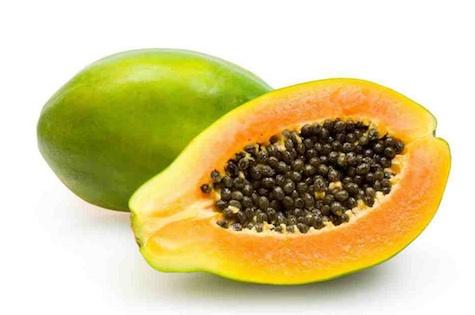Aussie red papaya and yellow papaw growers are calling on families to make the most of the delicious tropical fruit this spring.
Although available all year round, the local industry will enjoy a bountiful supply of fruit until November, when it will be at its best.
Queensland papaya grower, Daniel MacKay, says the red and yellow fruits are a lot more versatile than people think, making them a perfect ingredient for families.
“While red papaya and yellow papaw are often eaten on their own, there are many other ways the whole family can enjoy these delicious fruits.
“Chopped papaya or papaw goes well in desserts like cakes, and they’re packed with vitamins A and C and fibre, making them a great ingredient in any summer smoothie,” he says.
“One of my family’s favourite ways to enjoy red papaya and yellow papaw during the warmer weather is in a salad. The fruits’ sweetness provides a contrast against other fresh savoury ingredients like cucumber and herbs,” says McKay.
Although most people think red papaya and yellow papaw are the same fruit, the two actually have distinct differences. Yellow papaw is larger and has a more rounded shape, with pale orange skin and distinctive yellow flesh.
Red papaya has an orange-red flesh with yellow-orange skin and is more oblong in shape.
Fat free and low in kilojoules, these tropical fruits contain a wide variety of vitamins and minerals.
Just 150g provides more than twice the recommended daily requirement of vitamin C, as well as vitamin A, calcium, iron, carbohydrates and a wealth of protective antioxidant carotenoids.
As they grow best in warm humid climates, red papaya and yellow papaw are predominately grown in Northern Queensland, Sunshine Coast districts, as well as in the Northern Territory and Western Australia.
When selecting fruit, MacKay advises treating red papaya and yellow papaw as you would an avocado or pear.
“If fruit is ripe it will give slightly when pressed near the stem. Select fruits with a yellow-green skin and allow them to ripen for a few days at room temperature before cutting.
“If you are going to eat them straight away, choose fruit that is soft to touch with almost completely yellow skin and store them in the fridge,” he says.
“The fruits are now at their juicy best as we come into the warmer weather. The whole family can enjoy red papaya and yellow papaw this spring, whether in salads, cakes, breakfast or a snack on their own,” concludes MacKay.
Australian red papaya and yellow papaw growers offer two simple recipes that are perfect for spring to show families more ways to make the most of the fruits while they are at their peak:
Lemongrass chicken with papaw and cucumber salad

Serves 4
Prep: 15 minutes
Cooking: 10 minutes
Ingredients
4 (about 150g each) chicken breast fillets
1 stem lemongrass, pale section only, finely chopped
2 teaspoons peanut oil
1 tablespoon fresh lime juice
2 teaspoons fish sauce
2 teaspoons brown or palm sugar
½ teaspoon sesame oil
1/2 pawpaw, deseeded, peeled, very thinly sliced
2 Lebanese cucumbers, end trimmed, thinly sliced lengthways into ribbons
½ cup round mint leaves
½ cup Thai basil leaves
1/3 cup toasted peanuts, coarsely chopped
Steamed Jasmine rice, to serve
Method
1. Preheat oven to 180°C. Place the chicken and lemon grass in a large bowl. Drizzle with oil and gently toss to combine. Season with salt and pepper.
2. Heat a large frying pan over medium-high heat. Cook chicken for 2 minutes each side or until golden. Transfer to an oven tray and bake for 8 minutes or until just cooked through. Remove from heat and set aside for 5 minutes to rest.
3. Meanwhile, combine the lime juice, fish sauce, sugar and sesame oil in a small bowl. Place the papaw, cucumber, mint and basil in a large bowl. Drizzle with dressing and gently toss to combine. Divide evenly among serving plates.
4. Thickly slice chicken and place on serving plates. Sprinkle with peanuts and serve immediately, with steamed rice, if desired.
Tips: For a summery change, use salmon fillets or tuna steaks instead of the chicken. Cook salmon or tuna on a chargrill, 2-3 minutes each side for salmon; 1 minute each side for tuna.
Papaya and banana bread with honeycomb butter

Serves 6-8
Prep: 15 minutes
Cooking: 1 hour
Ingredients
2 cups (300g) self-raising flour
1 cup (200g) brown sugar
1 teaspoon baking powder
½ cup (125ml) mashed papaya
½ cup (125ml) mashed banana
2 eggs, lightly whisked
150g butter, melted, cooled
½ cup (70g) toasted macadamias, coarsely chopped
½ cup finely chopped papaya, extra
Honeycomb butter:
100g butter, softened
30g honeycomb, coarsely chopped
Method
1. Preheat oven to 180°C. Grease and line the base and sides of a 8 x 24cm (base measurement) loaf pan.
2. Combine the flour, sugar and baking powder in a large bowl.
3. Combine mashed papaya, banana and eggs in a small bowl. Add to the flour mixture with the melted butter, macadamias and extra papaya and gently stir until just combined. Spoon into the prepared pan and smooth the surface with the back of a spoon. Place on an oven tray and bake for 1 hour or until a skewer inserted in the centre comes out clean. Remove from oven. Set aside for 10 minutes before turning onto a wire rack to cool.
4. Meanwhile, to make honeycomb butter, use an electric mixer to beat butter until pale. Add honeycomb and stir to combine.
5. Cut into thick slices and dollop with honeycomb butter. Serve warm or at room temperature.

















__small.png)










